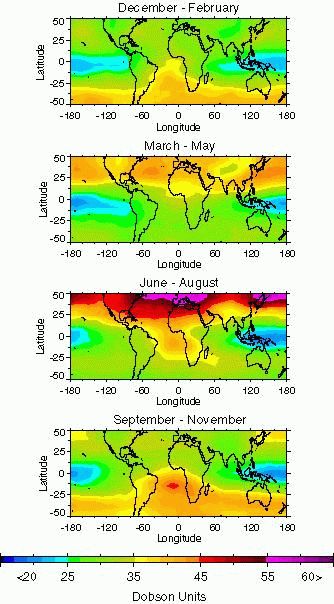![[Earth]](../img/earth.gif)
TRACE: Seasonal Variability of Tropospheric Ozone
![[GTE Logo]](../img/gte_slogo.gif)
![[Earth]](../img/earth.gif) |
TRACE: Seasonal Variability of Tropospheric Ozone |
![[GTE Logo]](../img/gte_slogo.gif) |
 |
A novel procedure for combining ozone measurements from existing satellites has led to global maps of tropospheric ozone, such as those illustrated here. The new analysis technique is conceptually simple. The amount of ozone in the stratosphere as determined from measurements by a limb viewing instrument, such as the SAGE II instrument, is subtracted from the total amount of ozone as determined from a nadir viewing instrument, such as the TOMS instrument. The resulting difference in ozone concentration, called the tropospheric ozone residual (TOR), is the amount of ozone in the lower regions of the atmosphere. The left panel depicts the average of the tropospheric residuals obtained using this analysis technique for four seasons . The high concentrations of tropospheric ozone observed in the northern hemisphere for the June- August season was expected, knowing that most industrial emissions occur in the northern mid-latitudes. Totally unexpected was the enhanced concentrations of tropospheric ozone observed during the September-November time period in the tropical Atlantic ocean between southern Africa and South America. The TRACE-A mission was initiated to determine the cause of this large pool of ozone. Notice also that the September - November tropospheric ozone residuals tend to spread in a latitudinal zone, centered on 30 degrees south, into the Indian ocean and, eventually, into the Pacific ocean. The PEM-Tropics mission, completed in September, 1996, observed plumes of enhanced ozone throughout the tropical Pacific, which were clearly associated with biomass burning. |
[Return to the GTE
Home Page]
[Return to the TRACE Summary]
[Feedback]